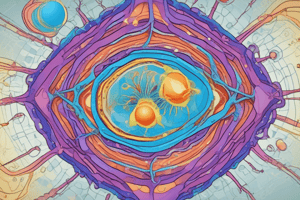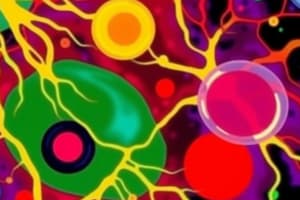Podcast
Questions and Answers
What is the primary function of lysosomes in a cell?
What is the primary function of lysosomes in a cell?
- To generate energy through ATP production
- To synthesize proteins for cellular functions
- To transport substances out of the cell
- To digest macromolecules and non-usable materials (correct)
Which structure is responsible for the formation of lysosomes?
Which structure is responsible for the formation of lysosomes?
- Mitochondria
- Nucleus
- Golgi apparatus (correct)
- Endoplasmic reticulum
What type of enzymes do lysosomes contain?
What type of enzymes do lysosomes contain?
- Oxidative enzymes
- Transfer enzymes
- Receptor enzymes
- Hydrolytic enzymes (correct)
In which cellular process do lysosomes play a crucial role?
In which cellular process do lysosomes play a crucial role?
What happens to materials that enter lysosomes?
What happens to materials that enter lysosomes?
What type of proteins do ribosomes synthesize for use within the cell?
What type of proteins do ribosomes synthesize for use within the cell?
Which statement accurately describes the Golgi apparatus?
Which statement accurately describes the Golgi apparatus?
What structural components make up the Golgi apparatus?
What structural components make up the Golgi apparatus?
What role do enzymes in the saccules of the Golgi apparatus play?
What role do enzymes in the saccules of the Golgi apparatus play?
Which of the following statements is NOT true regarding intracellular proteins?
Which of the following statements is NOT true regarding intracellular proteins?
What role do muscle and nerve cells primarily have in the process of cellular respiration?
What role do muscle and nerve cells primarily have in the process of cellular respiration?
Which statement best describes the consequence of using oxygen in energy production for muscle and nerve cells?
Which statement best describes the consequence of using oxygen in energy production for muscle and nerve cells?
Which process is directly responsible for providing ATP to muscle and nerve cells?
Which process is directly responsible for providing ATP to muscle and nerve cells?
What is the primary substrate broken down in reactions that produce ATP in muscle and nerve cells?
What is the primary substrate broken down in reactions that produce ATP in muscle and nerve cells?
Why is oxygen crucial for the reactions carried out by muscle and nerve cells?
Why is oxygen crucial for the reactions carried out by muscle and nerve cells?
What is the primary function of the cytoskeleton in a cell?
What is the primary function of the cytoskeleton in a cell?
Which protein is primarily found in microfilaments?
Which protein is primarily found in microfilaments?
Microfilaments are characterized by which of the following features?
Microfilaments are characterized by which of the following features?
Which of the following statements about the cytoskeleton is incorrect?
Which of the following statements about the cytoskeleton is incorrect?
What role do microfilaments play in the architecture of the cell?
What role do microfilaments play in the architecture of the cell?
What is the structural composition of centrioles?
What is the structural composition of centrioles?
How are centrioles positioned relative to each other?
How are centrioles positioned relative to each other?
Where are centrioles located within a cell?
Where are centrioles located within a cell?
Which statement about centrioles is accurate?
Which statement about centrioles is accurate?
Which of the following describes the arrangement of microtubules in centrioles?
Which of the following describes the arrangement of microtubules in centrioles?
What primary protein is found in microtubules?
What primary protein is found in microtubules?
How do microtubules contribute to cell structure and function?
How do microtubules contribute to cell structure and function?
What can damage the fibers found in skin, according to the content provided?
What can damage the fibers found in skin, according to the content provided?
Which of the following statements about microtubules is NOT true?
Which of the following statements about microtubules is NOT true?
Which characteristics distinguish microtubules from microfilaments?
Which characteristics distinguish microtubules from microfilaments?
Flashcards
Intracellular Ribosomes
Intracellular Ribosomes
Ribosomes that create proteins used within the cell, such as some hormones and digestive enzymes.
Golgi Apparatus
Golgi Apparatus
Organelle in cells that modifies and packages proteins.
Saccules
Saccules
Flattened, membrane-bound sacs in the Golgi apparatus.
Golgi Protein Modification
Golgi Protein Modification
Signup and view all the flashcards
Golgi Receives Vesicles
Golgi Receives Vesicles
Signup and view all the flashcards
What are lysosomes?
What are lysosomes?
Signup and view all the flashcards
What is the function of lysosomes?
What is the function of lysosomes?
Signup and view all the flashcards
What do lysosomes digest from outside the cell?
What do lysosomes digest from outside the cell?
Signup and view all the flashcards
What do lysosomes digest from inside the cell?
What do lysosomes digest from inside the cell?
Signup and view all the flashcards
Why are lysosomal enzymes contained within a membrane?
Why are lysosomal enzymes contained within a membrane?
Signup and view all the flashcards
Mitochondria
Mitochondria
Signup and view all the flashcards
Mitochondria Location
Mitochondria Location
Signup and view all the flashcards
Cellular Respiration
Cellular Respiration
Signup and view all the flashcards
ATP
ATP
Signup and view all the flashcards
Aerobic Respiration
Aerobic Respiration
Signup and view all the flashcards
Cytoskeleton
Cytoskeleton
Signup and view all the flashcards
Microfilaments
Microfilaments
Signup and view all the flashcards
Autophagy
Autophagy
Signup and view all the flashcards
Lysosomes
Lysosomes
Signup and view all the flashcards
Lysosomal enzymes
Lysosomal enzymes
Signup and view all the flashcards
What are microtubules?
What are microtubules?
Signup and view all the flashcards
What is the function of microtubules?
What is the function of microtubules?
Signup and view all the flashcards
What happens when microtubules are damaged?
What happens when microtubules are damaged?
Signup and view all the flashcards
Why does our skin get thinner with age?
Why does our skin get thinner with age?
Signup and view all the flashcards
What are centrioles?
What are centrioles?
Signup and view all the flashcards
What is the role of centrioles in cell division?
What is the role of centrioles in cell division?
Signup and view all the flashcards
How are centrioles arranged?
How are centrioles arranged?
Signup and view all the flashcards
How are the microtubules arranged within a centriole?
How are the microtubules arranged within a centriole?
Signup and view all the flashcards
Why are centrioles important for cell division?
Why are centrioles important for cell division?
Signup and view all the flashcards
Study Notes
Cell Organelles
- Mitochondria: Rod-shaped organelles with a double membrane. The inner membrane folds into cristae, where the electron transport chain (ETC) is located. They have their own DNA and synthesize proteins needed for oxidative metabolism, producing ATP (cellular energy). Abundant in muscle and nerve cells.
Cytoskeleton
- Cytoskeleton: A network of protein fibers that maintain cell shape, anchor organelles, and facilitate movement of cell parts. Includes microfilaments (actin), microtubules (tubulin), and intermediate filaments.
Centrioles
- Centrioles: Short cylinders composed of microtubules. Found in pairs, lying at right angles to each other near the nucleus. They direct the formation of the mitotic spindle during cell division and give rise to basal bodies that direct the formation of cilia and flagella.
Cilia and Flagella
- Cilia and Flagella: Motile appendages found on some cells. Cilia and flagella have a basal body (similar to a centriole) at their base, with a structure of microtubules. Cilia are found in respiratory tracts and fallopian tubes. Flagellum propels sperm cells.
Nucleus
- Nucleus: The largest organelle, enclosed by a double-layered nuclear membrane continuous with the endoplasmic reticulum (ER). Contains chromatin (invisible in non-dividing cells) which condenses into chromosomes during cell division. Chromosomes contain genes composed of DNA. The nucleus controls cellular metabolism and characteristics. It contains one or more nucleoli (dark bodies) which produce rRNA. The nucleus also controls cell division.
Endoplasmic Reticulum (ER)
- Endoplasmic Reticulum (ER): A network of membranous tubules and sacs. Continuous with the nuclear membrane. Two types:
- Rough ER: Studded with ribosomes, involved in protein synthesis.
- Smooth ER: Lacks ribosomes and has functions including lipid production, calcium storage, and detoxification reactions.
Ribosomes
- Ribosomes: Small, dense granules composed of rRNA and proteins. Synthesize proteins. Found free in the cytoplasm or attached to rough ER.
Golgi Apparatus
- Golgi Apparatus: Composed of flattened sacs. Modifies proteins received from the ER, packages proteins into vesicles for secretion or use within the cell, and produces membrane components and lysosomes.
Lysosomes
- Lysosomes: Membrane-bound vesicles containing hydrolytic enzymes. Digest macromolecules entering the cell, break down non-usable materials, and recycle cellular components (autophagy).
Peroxisomes
- Peroxisomes: Similar to lysosomes, containing oxidative enzymes. Break down harmful substances, like free radicals, and detoxify substances.
Studying That Suits You
Use AI to generate personalized quizzes and flashcards to suit your learning preferences.





